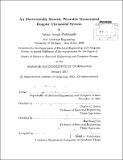| dc.contributor.advisor | Charles G. Sodini and Hae-Seung Lee. | en_US |
| dc.contributor.author | Pietrangelo, Sabino Joseph | en_US |
| dc.contributor.other | Massachusetts Institute of Technology. Department of Electrical Engineering and Computer Science. | en_US |
| dc.date.accessioned | 2013-06-17T19:49:33Z | |
| dc.date.available | 2013-06-17T19:49:33Z | |
| dc.date.copyright | 2013 | en_US |
| dc.date.issued | 2013 | en_US |
| dc.identifier.uri | http://hdl.handle.net/1721.1/79234 | |
| dc.description | Thesis (S.M.)--Massachusetts Institute of Technology, Dept. of Electrical Engineering and Computer Science, 2013. | en_US |
| dc.description | Cataloged from PDF version of thesis. | en_US |
| dc.description | Includes bibliographical references (p. 137-144). | en_US |
| dc.description.abstract | This thesis details the design of a transcranial Doppler (TCD) ultrasound system to measure cerebral blood flow velocity (CBFV) at the middle cerebral artery (MCA). TCD sonography has been clinically indicated in a variety of neurovascular diagnostic applications. Acceptance of conventional TCD methods, however, has been primarily impeded by several constraints, including restrictive system form factors, measurement reliability concerns, and the need for a highly-skilled operator. The goal of this work is to reduce the effects of such limitations through the development of a highly-compact, wearable TCD ultrasound system for autonomous CBFV measurement. A first-generation, eight channel printed circuit board prototype system has been designed, fabricated, and experimentally tested. Characterization of the prototype system using a Doppler flow phantom resulted in a normalized root-mean-square error of < 3.5% over the range of expected in vivo MCA flow velocities. Extension of the initial prototype to higher channel count systems and the development of phased array beamformation and algorithmic vessel location are also examined in this work. The emergence of simple, robust, and non-invasive neurovascular diagnostic methods presents an enormous opportunity for the advancement of neurovascular monitoring, particularly in applications where - due to restrictions in current diagnostic modalities - standard monitoring procedures have not yet been established. | en_US |
| dc.description.statementofresponsibility | by Sabino Joseph Pietrangelo. | en_US |
| dc.format.extent | 144 p. | en_US |
| dc.language.iso | eng | en_US |
| dc.publisher | Massachusetts Institute of Technology | en_US |
| dc.rights | M.I.T. theses are protected by
copyright. They may be viewed from this source for any purpose, but
reproduction or distribution in any format is prohibited without written
permission. See provided URL for inquiries about permission. | en_US |
| dc.rights.uri | http://dspace.mit.edu/handle/1721.1/7582 | en_US |
| dc.subject | Electrical Engineering and Computer Science. | en_US |
| dc.title | An electronically steered, wearable transcranial doppler ultrasound system | en_US |
| dc.type | Thesis | en_US |
| dc.description.degree | S.M. | en_US |
| dc.contributor.department | Massachusetts Institute of Technology. Department of Electrical Engineering and Computer Science | |
| dc.identifier.oclc | 845314430 | en_US |
